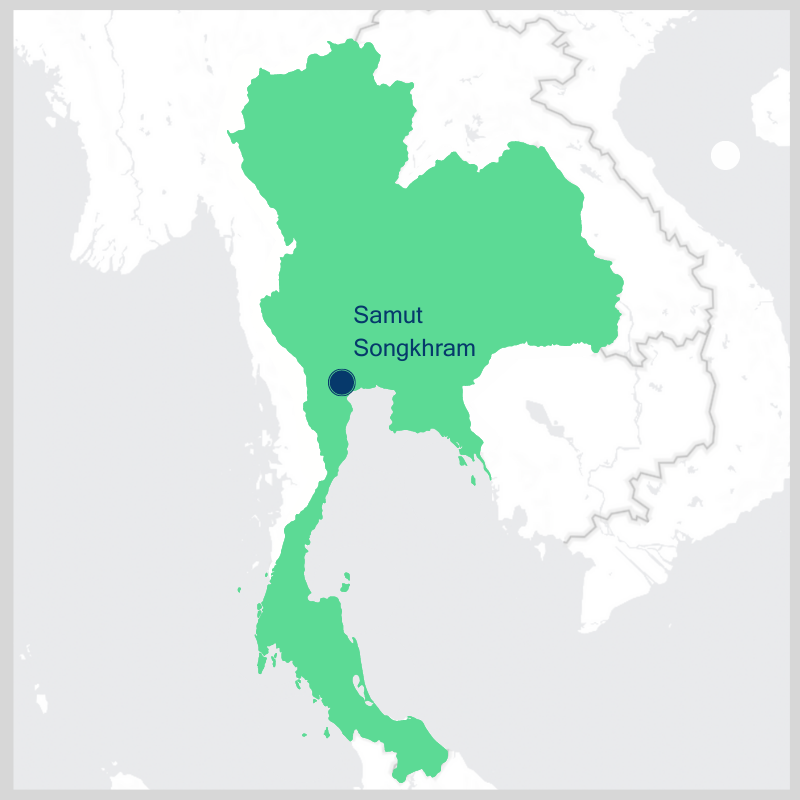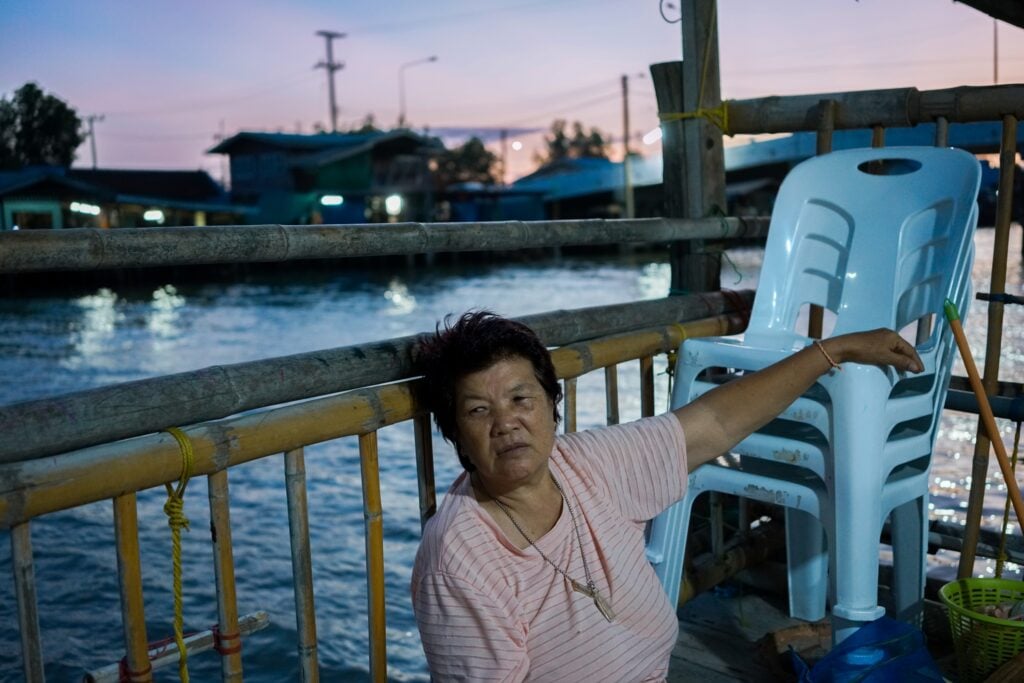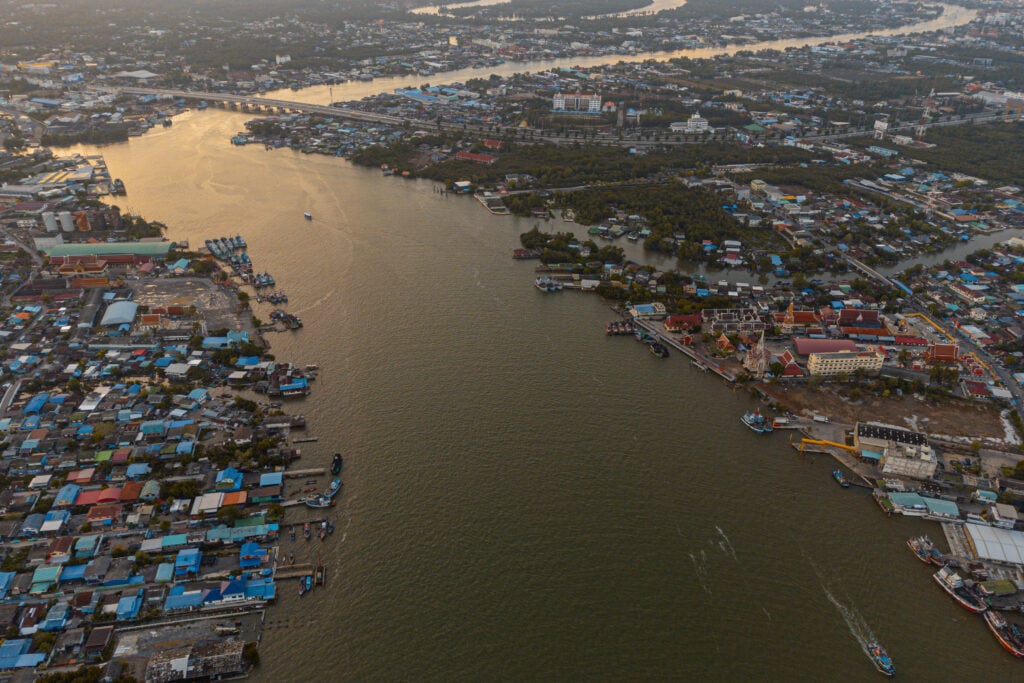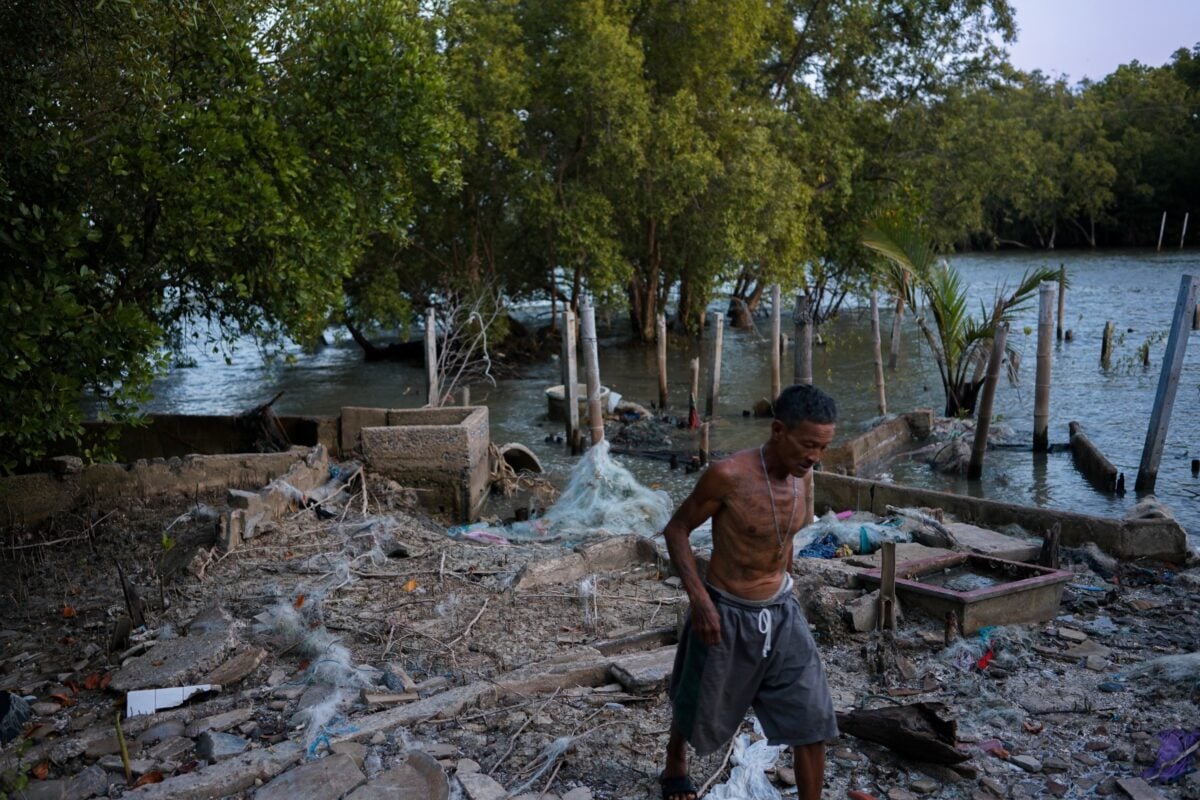SAMUT SONGKHRAM, THAILAND – The only things between Sopha Bantengchai’s wooden house and the ocean are a small wall built of old car tires filled with concrete and a thin strip of mangrove forest made up of about 10 trees.
However, these barriers cannot shield her house from the waves that hit Pak Klong Bang Bo village on the coast of Thailand’s Samut Songkhram province.
Two years ago, the neighbor’s house in front of hers was swept away by powerful waves during a sudden storm surge – leaving her house and her family of six on the front lines in the Bay of Bangkok, where the sea has been steadily eating away the coastal land.
There were 10 houses in front of hers a decade ago. But they have now disappeared, along with the vibrant fishing community.

The ground floor of her house has been inundated with water and her family now lives on the second floor. They have given up repairing the ground floor because of the constant damage by waves.
“I’m not sure how long we can live in this house. It rocks every time it is hit by the waves during a high tide. It is only a matter of time before this house can no longer withstand the force of the waves,” she said.
Sopha knows there is little chance of saving her home and ancestral land. She has bought a new house further inland in preparation for the day they have to evacuate the old house.
“It is a very hard decision to uproot the entire family and move away. But the environment has become too hostile for us,” she said.



Her village is not the only area in Thailand affected by rapid coastal erosion. Many coastal communities along the Bay of Bangkok have suffered the same fate.
The Department of Marine and Coastal Resources’ data show that cities along the Bay of Bangkok lose between one and five meters of coastal area each year, and in some cases more – prompting authorities to build sea walls along the coast.
Climate change causing the sea to rise is one of the many culprits, combined with the loss of mangrove forests that prevent erosion and the over-use of groundwater that makes the land around the bay sink.
Higher tides
Situated in the northern part of the Gulf of Thailand, the Bay of Bangkok is one of Thailand’s bustling economic hubs, hosting densely populated cities like Bangkok, Samut Songkhram, Samut Sakhon and Samut Prakan.
Samut means the sea in Thai. This prefix in the province names indicates the people’s dependence on the water for building their economy and livelihoods.
Known for its famous Amphawa floating market, Samut Songkhram is a hotspot for marine logistics, tourism, fisheries, and aquaculture.
It is also where the rivers – the Mae Klong, Tha Chin, and Chao Phraya – meet the sea, nourishing brackish-water agriculture that provides a unique taste in fruit. But these economic activities have now been disrupted by rising sea levels.

A 2021 study released in the Science Essence Journal on sea level changes in the Gulf of Thailand showed that water levels have linearly increased between 0.72 and 19.19 millimeters per year in between 1977 and 2019.
The study analyzed water level data from 18 tide gauge stations along the gulf. It showed the average rate of sea level change in the Bay of Bangkok was higher than in other coastal areas along Thailand’s eastern coast.
The sea level changes in Samut Sakorn and Samut Songkhram increased by about 16.27 and 10.44 millimeters per year, “which is very high,” wrote the author. This may be caused by multiple factors, including rainfall, rising temperatures and soil subsidence – further studies are needed.
What this study emphasized, however, was the increasing threat of rising sea levels, as a previous study released in 2013 showed the sea levels had increased by about five millimeters per year from 1985 to 2009.
An Intergovernmental Panel on Climate Change (IPCC) report indicated that even a small increase in the sea level can cause destruction from flooding, coastal erosion, salt intrusion, the loss of wildlife habitats and human displacement.
The report also pointed out that the human-induced heating of the climate system would lead to an increase in the global mean sea level by 0.5 to one meter by the end of this century.

With the cities along the Bay of Bangkok sitting in low-lying areas – they are only about 1.5 meters above sea level – the entire area is at high risk of being submerged if the sea level continues to rise.
Climate Central’s analysis shows that only one meter of sea level rise can wipe up nearly the entire Samut Songkhram – and many residents are aware of the danger.
A sour taste for fruit farmers
In the hinterland of Samut Songkhram there are many lychee and pomelo orchards fed by the seasonal brackish water, which brings a unique taste to the fruit and is highly sought after.
These two fruits have become famous in their home in Amphawa and Bang Khonthi districts, but the crops are now suffering lower yields.
Over the past six years, the fruit trees have not had annual yields. Farmers were able to harvest lychees in 2018, 2021, and this year. But in other years customer demands could not be met.
Manas Boonpayung, a local fruit farmer and a leader in Bang Sakae subdistrict in Bang Khonthi, said the decline in fruit production had started because of the increasing salinity, or salt, intrusion, and warmer weather.
Lychee trees can tolerate saline water to a certain level and need an extended period of cool weather of no higher than 18 degrees Celsius for a duration of at least 15 days to flower and bear fruit.
“The famous legacy of Samut Songkhram’s lychee and pomelo happens because of fertile soil from river sediment, cool weather during winter and appropriate salinity levels in the water – giving the fruit that grows here its unique taste,” said Manas.
“Our fruit orchards depended on these specific environmental conditions. The sea rising and climate change have been altering the environmental balance, which can ultimately put an end to our famous crops.”


“The most glaring impact of the sea level rise in Samut Songkhram is more frequent coastal flooding,” said Bandit Pansawat, a resident who started a social media group that crowd-sources flooding reports and data from social media users.
Every October in the monsoon season, the low-lying Samut Songkhram has experienced floods due to high tides.
Locals used to see these floods as manageable as it was seasonal and lasted for only a few days. But the floods in recent years have been different. The water levels have been higher and the floods increased in frequency and lasted longer.
Last year, heavy rain coupled with a high tide in the Bay of Bangkok caused a sudden flood at the Amphawa market, a famous tourist attraction.
Many vendors stood in the water selling their goods, while transportation ground to a halt in the waist-high water, bringing local tourism to a grinding halt. Locals claimed it was the worst flood in 70 years, and the severity level of the flood coming this October is unknown.
“It is apparent to me that the flood was more severe than when I was young,” said Bandit. “In the past, coastal flooding would happen about once or twice a year during the spring tides [in the monsoon season.] We are now facing flooding almost every high tide period.”
Pongrat Piromra, the Director-General of the Department of Public Works and Town and Country Planning (DPT), revealed that his department was preparing a 950-million-baht (US$26.8 million) project to build a series of flood walls around the province’s inner city to protect the city center from inundation.
Its construction will likely start in 2024 and the walls will allow the low-lying area to withstand up to 2.5 meters of floodwater and protect the residents.
To mitigate the impact of salinity intrusion and flooding, the Thai government implemented 175 water management projects between 2018 and 2022. They include flood dikes, sluice gates and water gates in the canals to block saline water entering from the sea.
Although these large-scale projects have been well received, some residents are concerned about riverbank ecology and people’s dependency on the water.
The cities across the Bay of Bangkok usually rely on the interconnected system of canals, that offer them access to water sources and transportation routes. This system gets disrupted when dikes and water gates are built on canals.
Living with water
Despite the more severe floods, local people have not left – they have learned to adapt.
One of the common adaptation methods is placing layers of sandbanks in front of their houses to block the water. Many also lifted the floors of their houses or shops to escape the high tides.
Finding ways to live with the water is also the choice of many living in the coastal areas next to the Bay of Bangkok. But many also question if these methods will continue to be effective in the face of alarming sea level rises.

Bandit believes the availability of water data will help people in his province adapt to the more frequent floods.
In October, he started the Samut Songkhram Self-Management Facebook group, aimed at encouraging local people to discuss local problems and solutions, especially those related to coastal flooding.
The group acts as a platform crowd-source for the flood data by asking members to collect the time, date, water height and location of flooded areas and send the data to the group. This data can then alert local people to be prepared or to move their belongings in their compounds.
He hopes to gather enough crowd-sourced flood data to map out the flood risk areas of the province, which can be used for shaping climate mitigation and adaptation initiatives.
“I hope that our initiatives will inspire other local communities elsewhere to try and come up with their own solutions to cope with climate change and secure their future,” he said.
Supported by the Internews’ Earth Journalism Network, this story is part of a series on the impact of rising sea levels in the Bay of Bangkok and the local initiative to create resilience.
Visarut Sankham is a visual storyteller and documentary photographer based in Chiang Mai, Thailand.





